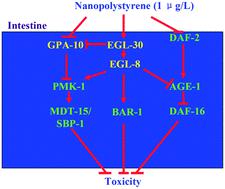当前位置:
X-MOL 学术
›
Environ. Sci.: Nano
›
论文详情
Our official English website, www.x-mol.net, welcomes your
feedback! (Note: you will need to create a separate account there.)
Response of intestinal Gα subunits to nanopolystyrene in nematode Caenorhabditis elegans
Environmental Science: Nano ( IF 5.8 ) Pub Date : 2020-06-16 , DOI: 10.1039/d0en00561d Yunhan Yang 1, 2, 3, 4 , Huihui Du 4, 5, 6 , Guosheng Xiao 4, 5, 6 , Qiuli Wu 1, 2, 3, 4 , Dayong Wang 1, 2, 3, 4
Environmental Science: Nano ( IF 5.8 ) Pub Date : 2020-06-16 , DOI: 10.1039/d0en00561d Yunhan Yang 1, 2, 3, 4 , Huihui Du 4, 5, 6 , Guosheng Xiao 4, 5, 6 , Qiuli Wu 1, 2, 3, 4 , Dayong Wang 1, 2, 3, 4
Affiliation

|
In organisms, Gα subunits transduce the signals from G protein-coupled receptors (GPCRs) to downstream cytoplasmic signaling pathways. However, the role of G proteins in regulating the response to nanoplastics remains largely unclear. Using Caenorhabditis elegans as an animal model, we identified intestinal Gα subunits involved in the control of response to nanopolystyrene (100 nm). After the exposure, nanopolystyrene in the range of μg L−1 could significantly increase the expression of egl-30 and decrease the expression of gpa-10. Intestine-specific RNAi knockdown of egl-30 induced susceptibility to nanopolystyrene toxicity, and intestine-specific RNAi knockdown of gpa-10 induced resistance to nanopolystyrene toxicity, suggesting that the alteration in intestinal EGL-30 and GPA-10 expressions mediated a protective response. Intestinal EGL-30 regulated the response to nanopolystyrene by activating the EGL-8/PLCβ. Moreover, in nanopolystyrene exposed nematodes, intestine-specific RNAi knockdown of egl-30 or egl-8 significantly decreased the expressions of pmk-1 encoding a p38 MAPK, bar-1 encoding a β-catenin transcriptional factor, and daf-16 encoding a FOXO transcriptional factor, and increased the expression of age-1 encoding a kinase acting downstream of insulin receptor DAF-2. Additionally, in nanopolystyrene exposed nematodes, intestine-specific RNAi knockdown of gpa-10 significantly increased the expressions of pmk-1 and its downstream signaling cascade of mdt-15-sbp-1. Therefore, intestinal Gα subunits (EGL-30 and GPA-10) were involved in the control of response to nanopolystyrene by regulating the downstream insulin, p38 MAPK, and/or Wnt signaling pathways. Our results highlight the crucial function of intestinal Gα subunits in response to nanoplastics in the range of μg L−1 in organisms.
中文翻译:

线虫秀丽隐杆线虫肠道Gα亚基对纳米聚苯乙烯的反应。
在生物体中,Gα亚基将信号从G蛋白偶联受体(GPCR)传递到下游细胞质信号通路。但是,G蛋白在调节对纳米塑料响应中的作用仍不清楚。使用秀丽隐杆线虫作为动物模型,我们确定了肠道Gα亚单位参与控制对纳米聚苯乙烯(100 nm)的反应。暴露后,μgL -1范围内的纳米聚苯乙烯可显着增加egl-30的表达并降低gpa-10的表达。egl-30的肠特异性RNAi敲低引起对纳米聚苯乙烯毒性的敏感性,而gpa-10的肠特异性RNAi敲低诱导对纳米聚苯乙烯毒性的抗性,提示肠道EGL-30和GPA-10表达的改变介导了保护性反应。肠道EGL-30通过激活EGL-8 /PLCβ来调节对纳米聚苯乙烯的反应。此外,在暴露于纳米聚苯乙烯的线虫中,egl-30或egl-8的肠特异性RNAi敲低显着降低了编码p38 MAPK的pmk-1,编码β-catenin转录因子的bar-1和编码ap- mRNA的daf-16的表达。 FOXO转录因子,并增加了age-1的表达编码作用于胰岛素受体DAF-2下游的激酶。此外,在纳米聚苯乙烯暴露的线虫中,gpa-10的肠道特异性RNAi敲低显着增加了pmk-1的表达及其下游信号转导的mdt-15-sbp-1。因此,肠道Gα亚基(EGL-30和GPA-10)通过调节下游胰岛素,p38 MAPK和/或Wnt信号通路参与了对纳米聚苯乙烯的反应控制。我们的结果突出了肠道Gα亚基在生物体中微克L -1范围内响应纳米塑料的关键功能。
更新日期:2020-08-14
中文翻译:

线虫秀丽隐杆线虫肠道Gα亚基对纳米聚苯乙烯的反应。
在生物体中,Gα亚基将信号从G蛋白偶联受体(GPCR)传递到下游细胞质信号通路。但是,G蛋白在调节对纳米塑料响应中的作用仍不清楚。使用秀丽隐杆线虫作为动物模型,我们确定了肠道Gα亚单位参与控制对纳米聚苯乙烯(100 nm)的反应。暴露后,μgL -1范围内的纳米聚苯乙烯可显着增加egl-30的表达并降低gpa-10的表达。egl-30的肠特异性RNAi敲低引起对纳米聚苯乙烯毒性的敏感性,而gpa-10的肠特异性RNAi敲低诱导对纳米聚苯乙烯毒性的抗性,提示肠道EGL-30和GPA-10表达的改变介导了保护性反应。肠道EGL-30通过激活EGL-8 /PLCβ来调节对纳米聚苯乙烯的反应。此外,在暴露于纳米聚苯乙烯的线虫中,egl-30或egl-8的肠特异性RNAi敲低显着降低了编码p38 MAPK的pmk-1,编码β-catenin转录因子的bar-1和编码ap- mRNA的daf-16的表达。 FOXO转录因子,并增加了age-1的表达编码作用于胰岛素受体DAF-2下游的激酶。此外,在纳米聚苯乙烯暴露的线虫中,gpa-10的肠道特异性RNAi敲低显着增加了pmk-1的表达及其下游信号转导的mdt-15-sbp-1。因此,肠道Gα亚基(EGL-30和GPA-10)通过调节下游胰岛素,p38 MAPK和/或Wnt信号通路参与了对纳米聚苯乙烯的反应控制。我们的结果突出了肠道Gα亚基在生物体中微克L -1范围内响应纳米塑料的关键功能。











































 京公网安备 11010802027423号
京公网安备 11010802027423号